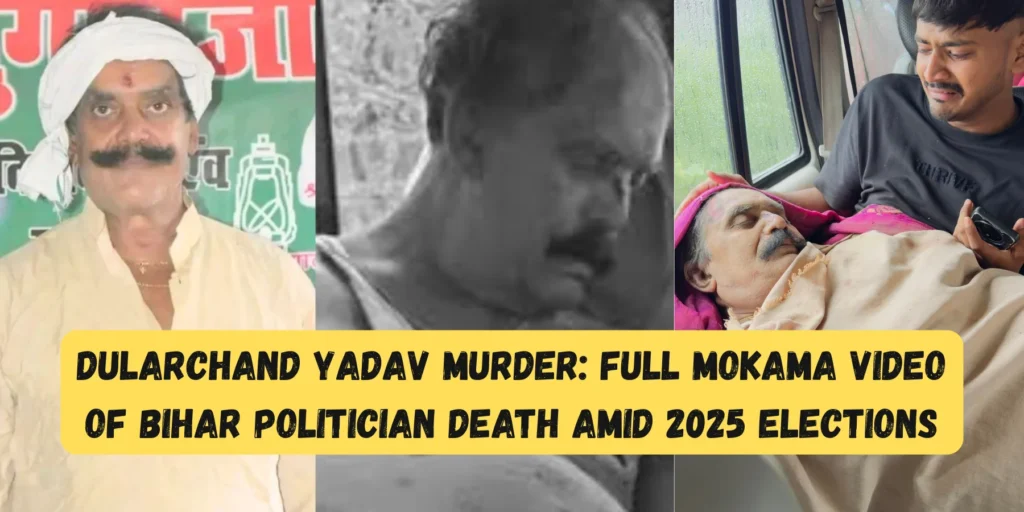
In the heated cauldron of Bihar’s 2025 Assembly elections, the Dularchand Yadav murder has ignited a firestorm, thrusting Mokama constituency into the spotlight and reviving ghosts of the state’s infamous “Jungle Raj” era. On October 30, 2025, the 76-year-old political heavyweight – once a feared don and close aide to RJD supremo Lalu Prasad Yadav – was killed in a brazen clash during a campaign rally for Jan Suraaj Party candidate Piyush Priyadarshi.
Eyewitnesses described a chaotic scene of gunfire, vehicle ramming, and caste-fueled frenzy, with fingers pointing straight at rival JD(U) strongman Anant Singh. As FIRs fly and postmortem reports add layers of intrigue, this Dularchand Yadav murder isn’t just a crime – it’s a political earthquake threatening Nitish Kumar’s “Sushasan Babu” legacy. Dive deep into the trending saga that’s dominating Bihar headlines, from the gory details to the man’s complex legacy.
The Dularchand Yadav Murder: A Timeline of Violence in Mokama
The Dularchand Yadav murder unfolded like a scene from Bihar’s turbulent 1990s, but with 2025’s high-stakes polls as the backdrop. Around 4 PM on October 30, Dularchand Yadav’s convoy crossed paths with that of Anant Singh – the five-time ex-MLA and JD(U) candidate from Mokama – in Basawan Chak village, near Patna. What started as a verbal spat over road space escalated into a full-blown brawl between Yadav’s Yadav caste supporters and Singh’s Bhumihar backers, a volatile mix in the caste-riven Mokama belt.
Eyewitnesses, including Jan Suraaj workers, recounted how Singh’s men allegedly opened fire first, striking Yadav in the leg. As chaos reigned, a vehicle from Singh’s group rammed Yadav’s SUV, crushing it under its wheels and dragging the body for meters. Videos circulating on X (formerly Twitter) show the mangled wreckage and bloodied scene, fueling viral outrage. Yadav was rushed to a local hospital but succumbed en route to Patna Medical College Hospital (PMCH).
By evening, three FIRs were filed at Mokama police station: one naming Anant Singh and four aides (including his brother and nephew) for murder under IPC Sections 302, 307, and Arms Act violations; another against Yadav’s group for rioting; and a third for vehicle damage. Two arrests followed – a Singh supporter and a Yadav aide – but Singh remains at large, denying involvement and calling it a “conspiracy” by rivals. The Election Commission deployed extra forces, postponing rallies in the area as tensions simmer.
This isn’t isolated; Mokama, once a poll violence hotspot with over 20 deaths in the 1990s, had seen relative peace under Nitish’s rule – until now. The Dularchand Yadav murder has trended nationwide on X, with #DularchandYadav garnering millions of views, blending grief, caste barbs, and calls for justice.
Postmortem Twists: Not a Bullet, But a Crushing End
Adding fuel to the Dularchand Yadav murder fire, the October 31 postmortem at PMCH revealed a bombshell: Yadav died not from the leg gunshot, but from severe chest trauma causing lung rupture and broken ribs. Doctors noted 12 injuries, including lacerations from being run over, pointing to vehicular homicide as the fatal blow. Bullet fragments were recovered, but the wound was non-lethal – a detail that has shifted scrutiny to the ramming incident.
Police are now probing CCTV footage and ballistics, with Singh’s camp claiming self-defense after Yadav’s men allegedly pelted stones. Forensic teams scoured the site, recovering shell casings, while Yadav’s family demands a CBI probe, alleging police bias toward Singh. As of November 1, no major breakthroughs, but the report has trended as #DularchandYadavPostmortem, sparking debates on whether this was premeditated murder or poll-time frenzy.
Political Fallout: A Blow to Nitish’s Image and Jan Suraaj’s Rise
The Dularchand Yadav murder has snowballed into a statewide crisis, with opposition parties – RJD’s Tejashwi Yadav and Congress – slamming Nitish Kumar for harboring “bahubalis” like Anant Singh, a five-time convict himself. Prashant Kishor, Jan Suraaj chief, halted campaigning, vowing to avenge the “martyrdom” and predicting a sympathy wave for his party in Mokama, where polling is November 6.
RJD’s Veena Devi visited Yadav’s family, promising justice, while AAP’s Sanjay Singh grilled the NDA in Rajya Sabha. BJP defended Singh as a “reformed leader,” but whispers of internal rifts grow. On X, hashtags like #JusticeForDularchand and #BiharJungleRaj have exploded, with over 50,000 posts in 24 hours, amplifying caste divides between Yadavs and Bhumihars. Analysts say this could cost JD(U) seats, echoing 1997’s poll violence that birthed Nitish’s anti-crime crusade.
Who Was Dularchand Yadav? From Village Boy to Mokama’s Iron Fist
Born around 1949 in Mokama taluka, Patna district, to Prasadi Yadav, Dularchand grew up in Bihar’s feudal heartland, where land disputes and caste loyalties shaped destinies. An 8th-pass “middle” category figure, he entered politics in the 1980s as a muscleman enforcing Yadav dominance in a Bhumihar-Yadav turf war.
Political Career and Key Achievements
Dularchand’s journey from enforcer to neta was marked by savvy alliances. A loyalist to Lalu Prasad since the 1990s RJD era, he wielded influence in Barh and Mokama, securing blocks for allies and mediating land feuds that boosted his clout. In 2010, he contested Barh on a JD(S) ticket, polling respectably despite losses. By 2025, he pivoted to Prashant Kishor’s Jan Suraaj, campaigning vigorously for Piyush Priyadarshi and symbolizing the party’s anti-establishment push. Achievements include fostering local Yadav networks that delivered votes and informal “development” like irrigation fixes – though often through strongarm tactics. His shift to Jan Suraaj was hailed as redemption, drawing youth to Kishor’s fold.
Controversies and Criminal Shadow
No profile of Dularchand is complete without his dark side. As of his 2010 affidavit, he faced 11 serious criminal cases, including four murders (IPC 302), three attempt-to-murder charges (IPC 307), kidnapping for murder (IPC 364), extortion (IPC 383), and Arms Act violations. No convictions, but cases spanned 1986–2010, painting him as Mokama’s “don-turned-neta.” Critics accused him of land grabs and poll rigging; in the murder clash, old videos resurfaced showing him hurling caste slurs at rivals. Yet, supporters viewed him as a Robin Hood against upper-caste oppression.
Net Worth and Assets: Modest for a Strongman
Unlike flashy celebs, Dularchand’s wealth was rooted in rural assets. His 2010 affidavit declared total movable and immovable assets at Rs 18 lakhs – agricultural land worth Rs 13 lakhs (13 bighas in joint family) and a spouse-owned house plot at Rs 5 lakhs. No cash, bank deposits, jewelry, or shares; no liabilities or tax filings. Post-2010 updates are scarce, but as a local influencer, his “net worth” likely hovered around Rs 50–100 lakhs by 2025, per unverified reports – far from opulent, tied to land holdings amid Bihar’s agrarian economy. No evidence of unexplained wealth, despite criminal probes.
Personal Life and Relationships
Dularchand was a family man in Mokama’s Yadav enclave, married with children who stayed out of the limelight. His spouse co-owned minor properties. Politically, he was Lalu Prasad’s trusted lieutenant in the 1990s–2000s, brokering RJD deals in Patna’s underbelly. By 2025, his bond with Prashant Kishor deepened, positioning him as Jan Suraaj’s Yadav face. Post-murder, his kin accused Anant Singh of a “caste conspiracy,” vowing to fight on. No high-profile romances or scandals; his life was politics and kin.
Car Collection: Practical, Not Lavish
Dularchand favored sturdy SUVs for Bihar’s rough roads, but no extravagant fleet. His 2010 affidavit listed zero motor vehicles. In the murder, he rode in a white Innova Crysta, crushed beyond recognition – a stark symbol of his end. Rumors suggest he owned 2–3 sedans like Toyota Fortuners for campaigns, valued under Rs 20 lakhs total – functional tools for a rural powerbroker, not a collector’s pride.
Frequently Asked Questions (FAQs) About Dularchand Yadav Murder
Q :- Who was Dularchand Yadav?
Dularchand Yadav was a 76-year-old Bihar politician, former Lalu Prasad aide, and Jan Suraaj supporter known as Mokama’s strongman with deep roots in Yadav politics.
Q :- How did the Dularchand Yadav murder happen?
During a October 30 campaign clash in Mokama, gunfire erupted between his group and Anant Singh’s supporters; Yadav was shot in the leg and fatally crushed by a ramming vehicle.
Q :- What does the postmortem say about Dularchand Yadav’s death?
He died from lung rupture and rib fractures due to crushing, not the gunshot wound, per PMCH report on October 31.
Q :- Who is accused in the Dularchand Yadav murder case?
Anant Singh and four aides face murder charges in one FIR; two arrests made, with investigations ongoing.
Q :- Why is the Dularchand Yadav murder trending?
It highlights Bihar’s poll violence fears, caste tensions, and Nitish Kumar’s law-order record, exploding on X amid 2025 elections.
Q :- What was Dularchand Yadav’s net worth?
Around Rs 18 lakhs in 2010 (land assets); likely Rs 50–100 lakhs by 2025, per estimates – modest for his influence.
Q :- Did Dularchand Yadav have criminal cases?
Yes, 11 serious ones in 2010, including murders and Arms Act violations, but no convictions.
Q :- How has the Dularchand Yadav murder affected Bihar elections?
It boosted Jan Suraaj sympathy votes in Mokama, embarrassed JD(U), and sparked opposition attacks on NDA’s “Sushasan.”
Q :- What cars did Dularchand Yadav own?
No official list; reportedly 2–3 SUVs like Innova for campaigns, nothing luxurious.
Q :- Will there be a CBI probe in Dularchand Yadav murder?
Yadav’s family demands it; no official nod yet, but political pressure mounts.
Q :- Who were Dularchand Yadav’s political allies?
Lalu Prasad (RJD) earlier; Prashant Kishor (Jan Suraaj) in 2025.
Q :- Is Anant Singh involved in Dularchand Yadav murder?
Accused in FIR, but he denies it; police probing his role.
Conclusion: A Stark Reminder of Bihar’s Unfinished Battle
The Dularchand Yadav murder – a cocktail of ambition, caste, and bullets – lays bare Bihar’s fragile peace, where strongmen like him and Anant Singh once ruled unchecked. From his gritty rise as Lalu’s shadow warrior to his fatal stand for Jan Suraaj, Yadav embodied the state’s raw, unpolished power dynamics. As polls near and probes deepen, this tragedy demands more than FIRs: real reform to bury Jungle Raj for good. Will Bihar choose fear or progress? The voters – and history – will decide. Stay tuned for updates on this unfolding saga.
For More Updates Stay Updated With CelebCars.in

